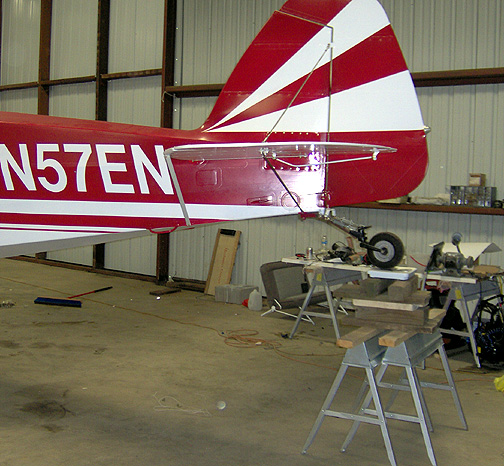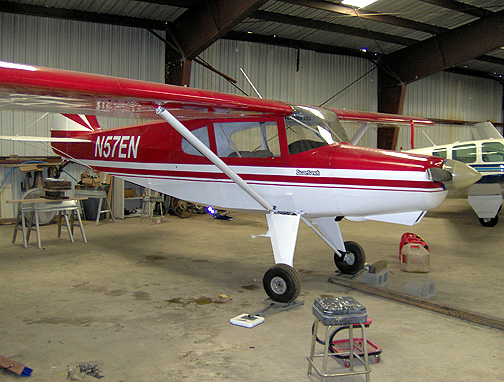
The geometry is figured for a 4:1 ratio. So simply read the scale and multiply by 4 for the weight.
April 19, 2008
With the airplane approaching completion, its time to do the weight & balance. All parts are installed, 8 qts. of oil has been poured in the engine and we are ready to weigh it. I checked around the local area FBO's to find some aircraft weighing scales, with no luck. I checked the internet and found them to be several thousand dollars and none for rent. Looking at Aircraft Spruce I found they have something called "Ruggles Aircraft Scales" for $275. These are just bathroom type scales but have an arm to act as a lever to reduce the weight enough to be within the capacity of a bathroom scale. Most bathroom scales have a maximum weight limit of 300 to 350 lbs. The mains will weigh over 500 lbs each, so a standard bathroom scale will not work.
I ended up finding a set of racing car scales on EBay that work on the same
principle as the Ruggles scales from Aircraft Spruce. Here is one of
the scales under the right main:

The geometry is figured for a 4:1 ratio. So simply read the scale
and multiply by 4 for the weight.
So, how did we get this scale device under the tire? As you can see
in the picture above, you can't get a jack under the axle extension. As
we were standing there scratching our heads, my father-in-law and building
partner Lonnie Gibbons came up with a very low tech way to lift the wheel
to allow me to slide the scale underneath:

Yep, a good old fashion lever and fulcrum, like we learned about in elementary
school.
With the scales centered under each main wheel, the tail was raised and blocked
up with a scale under the tailwheel. Blocks of wood were added until
the airplane was in level flight attitude as measured along the bottom door
frame of the front doors:

Finally, here is the whole picture of the weighing process:

So what does it weigh and just what do those weights mean?
Here are the weights:
Right Main = 625 lbs
Left Main = 613 lbs
Tailwheel = 100 lbs
Total Weight = 1,338 lbs.
Ok, so now that we know what it weighs, we can go ahead and figure out the Center of Gravity (C.G.) which is the balance part of the W&B equation. To figure the CG, we need to take a couple of measurements from the leading edge of the wing (the "datum"). With the aircraft in level flight attitude as shown above, we dropped a plumb bob on a string from the leading edge of the wing and marked it on the floor. The distance from the mark to the center of the main wheel axle was measured and it was exactly 3". Next, the distance from the plumb bob mark to the center of the axel on the tailwheel was measured, and we got 195"
Since the main wheels are forward of the datum (the lead edge of the wing) we count the 3" as a negative 3" (-3"). The tailwheel is positive 195" (+195") since it is aft of the datum.
So now to put it all together. Distances from the datum are called "arm". When you multiply the weight times the arm you get what is called the "moment". As an example the right main weighs 625 lbs and the arm is -3", so the moment of the right main is 625 x -3 = -1875 (that's negative1875).
Here is what it all looks like in a table:
Item |
Weight | Arm |
Moment |
| Main Gear - Left | 625 lbs | -3" | -1875 |
| Main Gear - Right | 613 lbs | -3" | -1839 |
| Tailwheel | 100 lbs | 195" | 19500 |
| . | . | . | . |
| Totals | 1,338 lbs | . | 15786 |
| C.G. | 11.80 | . | . |
The final CG is calculated by totalling the weights and the moments. Then
the total moment is divided by the total weight to get the center of gravity
(CG):
15786 / 1338 = 11.80 C.G.
Now that we have that basic information, we can work up some sample loads to determine how putting fuel, passengers and baggage on board affects the center of gravity (CG)
First we need to know the location (Arm) of the fuel, the seats, and the baggage compartment.
The front seats are located 15" aft of the datum (wing leading edge)
The rear seat is located 52" aft of the datum.
The fuel is located 24" aft of the datum
The baggage is located 77" aft of the datum
With this knowledge, we can plug in some loads to see where we are. Before
we do that, let's establish the maximum limits of weight and CG as determined
by the designer Bob Barrows. The maximum landing weight is 2500 lbs
(2700 lbs on floats). The limits of the CG range are 10.5" to 22.5",
or 16% to 34% of the mean aerodynamic chord (MAC) of the wing. (Note: to
get MAC divide the CG by 66 and express it as a percentage).
An example of a very forward CG loading would be a very light pilot, no
passengers, no baggage and minimal fuel on board.
| Item | Weight | Arm | Moment |
| Main Gear - Left | 625 lbs | -3" | -1875 |
| Main Gear - Right | 613 lbs | -3" | -1839 |
| Tailwheel | 100 lbs | 195" | 19500 |
| Front Seats | 100 lbs | 15" | 1500 |
| Rear Seats | . | 52" | . |
| Fuel (lbs.) | 36 lbs | 24" | 864 |
| Baggage | . | 77" | . |
| . | . | . | |
| Totals | 1,474 lbs. | . | 18150 |
| C.G. | 12.3 | . | . |
| MAC | 18.7% | . | . |
| . | . | . | . |
| Limits | . | . | . |
| Allowable Gross Weight | 2500 lbs | . | . |
| C.G. Range | 10.5 to 22.5 | . | . |
| MAC | 16% to 34% | . | . |
| . | . | . | . |
Now lets load it up with four people, full fuel and some baggage to get an aft CG condition.
| Item | Weight |
Arm | Moment |
| Main Gear - Left | 625 lbs | -3" | -1875 |
| Main Gear - Right | 613 lbs | -3" | -1839 |
| Tailwheel | 100 lbs | 195" | 19500 |
| Front Seats | 400 lbs | 15" | 6000 |
| Rear Seats | 350 lbs | 52" | 18200 |
| Fuel (lbs.) | 312 lbs | 24" | 7488 |
| Baggage | 100 lbs | 77" | 7700 |
| . | . | . | . |
| Totals | 2500 lbs | . | 55174 |
| C.G. | 22.1 | . | . |
| MAC | 33.4% | . | . |
| . | . | . | . |
| Limits | . | . | . |
| Allowable Gross Weight | 2500 lbs | . | . |
| C.G. Range | 10.5 to 22.5 | . | . |
| MAC | 16% to 34% | . | . |
| . | . | . | . |
Well that's about it. I'm very happy with the C.G., as it seems that I will be able to utilize the full capabilities of the Bearhawk without going outside of the CG limits. I can carry four real adults and a 100 lbs of baggage with no problem.